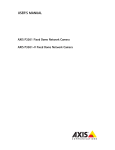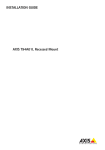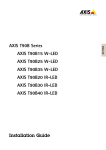Download User Manual AXIS Video Motion Detection 3
Transcript
AXIS Video Motion Detection 3 User Manual About This Document Learn More! This manual is intended for administrators and users of the application AXIS Video Motion Detection version 3.0.2. Later versions of this document will be posted to Axis website, as required. See also the online help, available from the application’s web-based interface. Visit Axis learning center www.axis.com/academy/ for useful trainings, webinars, tutorials and guides. Legal Considerations Video and audio surveillance can be regulated by laws that vary from country to country. Check the laws in your local region before using this product for surveillance purposes. Liability Every care has been taken in the preparation of this document. Please inform your local Axis office of any inaccuracies or omissions. Axis Communications AB cannot be held responsible for any technical or typographical errors and reserves the right to make changes to the product and manuals without prior notice. Axis Communications AB makes no warranty of any kind with regard to the material contained within this document, including, but not limited to, the implied warranties of merchantability and fitness for a particular purpose. Axis Communications AB shall not be liable nor responsible for incidental or consequential damages in connection with the furnishing, performance or use of this material. This product is only to be used for its intended purpose. Intellectual Property Rights Axis AB has intellectual property rights relating to technology embodied in the product described in this document. In particular, and without limitation, these intellectual property rights may include one or more of the patents listed at www.axis.com/patent.htm and one or more additional patents or pending patent applications in the US and other countries. This product contains licensed third-party software. See the menu item “About” in the product’s user interface for more information. This product contains source code copyright Apple Computer, Inc., under the terms of Apple Public Source License 2.0 (see www.opensource.apple.com/apsl). The source code is available from https://developer.apple.com/bonjour/ Trademark Acknowledgments AXIS COMMUNICATIONS, AXIS, ETRAX, ARTPEC and VAPIX are registered trademarks or trademark applications of Axis AB in various jurisdictions. All other company names and products are trademarks or registered trademarks of their respective companies. Apple, Boa, Apache, Bonjour, Ethernet, Internet Explorer, Linux, Microsoft, Mozilla, Real, SMPTE, QuickTime, UNIX, Windows, Windows Vista and WWW are registered trademarks of the respective holders. Java and all Java-based trademarks and logos are trademarks or registered trademarks of Oracle and/or its affiliates. UPnPTM is a certification mark of the UPnPTM Implementers Corporation. Contact Information Axis Communications AB Emdalavägen 14 223 69 Lund Sweden Tel: +46 46 272 18 00 Fax: +46 46 13 61 30 www.axis.com Support Should you require any technical assistance, please contact your Axis reseller. If your questions cannot be answered immediately, your reseller will forward your queries through the appropriate channels to ensure a rapid response. If you are connected to the Internet, you can: • download user documentation and software updates • find answers to resolved problems in the FAQ database. Search by product, category, or phrase • report problems to Axis support staff by logging in to your private support area • chat with Axis support staff (selected countries only) • visit Axis Support at www.axis.com/techsup/ AXIS Video Motion Detection 3 Table of Contents Application Overview . . . . . . . . . . . . . . . . . . . . . . . . . . . . . . . . . . . . . . . . Requirements . . . . . . . . . . . . . . . . . . . . . . . . . . . . . . . . . . . . . . . . . . . . . . . . . . Considerations . . . . . . . . . . . . . . . . . . . . . . . . . . . . . . . . . . . . . . . . . . . . . . . . . . Install Application . . . . . . . . . . . . . . . . . . . . . . . . . . . . . . . . . . . . . . . . . . Start and Stop the Application . . . . . . . . . . . . . . . . . . . . . . . . . . . . . . . . . . . . . Configure Application . . . . . . . . . . . . . . . . . . . . . . . . . . . . . . . . . . . . . . . Multichannel Products . . . . . . . . . . . . . . . . . . . . . . . . . . . . . . . . . . . . . . . . . . . Include Area . . . . . . . . . . . . . . . . . . . . . . . . . . . . . . . . . . . . . . . . . . . . . . . . . . . Exclude Area . . . . . . . . . . . . . . . . . . . . . . . . . . . . . . . . . . . . . . . . . . . . . . . . . . . Visual Confirmation . . . . . . . . . . . . . . . . . . . . . . . . . . . . . . . . . . . . . . . . . . . . . . Ignore Filters . . . . . . . . . . . . . . . . . . . . . . . . . . . . . . . . . . . . . . . . . . . . . . . . . . . Using the Application in an Action Rule . . . . . . . . . . . . . . . . . . . . . . . . . 3 4 4 4 5 5 6 6 6 7 7 7 10 AXIS Video Motion Detection 3 Application Overview Application Overview AXIS Video Motion Detection 3 is an application that detects moving objects in the camera’s field of view. When a moving object is detected, AXIS Video Motion Detection 3 sends an alarm that can be used by Axis network cameras and video encoders, and by third-party software, to, for example, record video or send a notification. To use AXIS Video Motion Detection 3, the application must first be uploaded to the Axis product and it must be started. To avoid detecting unwanted objects, the application should be configured. Include and exclude areas are used to define the parts of the scene in which moving objects should be detected. Ignore filters can be used to avoid detecting objects such as shadows of swaying trees, lights from passing cars and small animals regardless of where in the scene the objects appear. During configuration, visual confirmation can be used to help understand the effect of the different filters. When visual confirmation is enabled, red polygons show which objects the application detects and green polygons show which objects the application ignores. Requirements AXIS Video Motion Detection 3 can be installed in Axis network cameras and video encoders that support AXIS Camera Application Platform. The application is intended for fixed cameras and fixed domes. A complete list of compatible products and firmware versions is available at www.axis.com/applications The application does not require any license. For full functionality, Internet Explorer and AXIS Media Control (AMC) are required when configuring the application. Considerations Before using AXIS Video Motion Detection 3, take the following into consideration: • Small and distant objects might not be detected. • Detection accuracy may be affected by weather conditions such as heavy rain or snow. • Make sure that the lighting conditions are within the Axis product’s specification. Add additional lighting if needed. • Make sure that the camera is not subject to excessive vibrations. Vibrations might cause false detections. 4 AXIS Video Motion Detection 3 Install Application Install Application To download the application, go to www.axis.com/applications. There are two installation packages: • Application only. Select this option if the application is to be configured from a computer with Internet access. • Application and AXIS Media Control (AMC). Select this option if the application is to be configured from a computer without Internet access. AXIS Media Control is a software component for viewing video in Internet Explorer. For full functionality, AXIS Media Control is required when configuring the application. If the application is configured from a computer with Internet access, AXIS Media Control is downloaded and installed automatically. If the application is configured from a computer without Internet access, AXIS Media Control must be installed separately. Select the installation package that contains the AXIS Media Control installer. Unzip the file and run the AXIS Media Control installer. Install the application as described below. To install the application in an Axis network camera or video encoder, follow these steps: 1. Download the application as described above. 2. Go to Setup > Applications in the Axis product’s webpages. 3. Under Upload Application, click Browse, locate the application file and then click Upload Package. The application will appear under Installed Applications on the Applications page and under Overview in the menu. Note Applications can be uploaded by product administrators. Start and Stop the Application To start the application, select it in the Installed Applications list on the Applications page and click Start. To stop the application, select it in the list and click Stop. 5 AXIS Video Motion Detection 3 Configure Application Configure Application Once installed, the application is available from Setup > Applications > Motion Detection 3 in the Axis product’s webpages. Go to Settings and then click AXIS Video Motion Detection settings to open the application’s webpage. To configure AXIS Video Motion Detection 3, follow these steps: 1. Modify the size and position of the include area. This is the area in which moving objects will be detected. See Include Area on page 6 . 2. Optionally, add one or more exclude areas. Objects in an exclude area will be ignored. See Exclude Area on page 7 . 3. Click Save to apply the changes. 4. Use visual confirmation to verify the settings. See Visual Confirmation on page 7 . 5. If too many unwanted objects are detected, enable and configure one or more of the ignore filters. See Ignore Filters on page 7 . After modifying a setting, click Save to apply the changes. The video stream will be restarted and it may take a few seconds before the change is applied. Multichannel Products For multichannel products, the application can be used on all channels simultaneously. Each video channel has its own include area, exclude areas and ignore rules. To use the application on multiple channels, the application must be enabled and configured for each channel. • To switch between channels, click on the tabs below the video image. • To enable the application on a channel, switch to that channel and click Enable. It is recommended to only enable visual confirmation for one channel at a time. Make sure to disable visual confirmation before starting configuring another channel. Clicking Save will save changes on all channels. Include Area The include area is the area in which moving objects will be detected. Objects moving outside the include area will be ignored. The object will be detected also if only a part of the object is inside the include area. Note To modify the include area, Internet Explorer and AXIS Media Control (AMC) must be used. The default include area is a square that covers the whole image. Click on the icon to highlight the area. Use the mouse to reshape and resize the area so that it only covers the part of the image in which moving objects should be detected. The default square can be changed to a polygon with up to 20 points (corners). • To add a new point, click on the include area border. Drag the point to the desired position. • To remove a point, right-click on the point. • To move a point, drag the point to the new position. • To move the entire include area, place the mouse pointer inside the area. When the pointer becomes a cross, drag the area to the new position. 6 AXIS Video Motion Detection 3 Configure Application • To select the include area, click on the border. To reset the include area to its default size, click Reset. Exclude Area An exclude area is an area in which moving objects will be ignored. Use exclude areas if there are areas inside the include area that trigger a lot of unwanted detected objects. Up to 10 exclude areas can be used. Note To add and modify exclude areas, Internet Explorer and AXIS Media Control (AMC) must be used. To add an exclude area, click Add. The default exclude area is a rectangle placed in the center of the image. Use the mouse to move, reshape and resize the area so that it covers the desired part of the image. The default square can be changed to a polygon with up to 20 points (corners). • To move the exclude area, place the mouse pointer inside the area. When the pointer becomes a cross, drag the area to the new position. • To add a new point, click on the exclude area border. Drag the point to the desired position. • To remove a point, right-click on the point. • To move a point, drag the point to the new position. • To select an exclude area, click on the border. To remove an exclude area, select the area and then click Remove. To highlight the exclude areas, click on the icon. Visual Confirmation Visual confirmation is used to validate that the settings are correct, that is, that all objects that should be detected are detected. Note To use visual confirmation, Internet Explorer and AXIS Media Control (AMC) must be used. When visual confirmation is enabled, all moving objects found by the application will be encircled and followed by polygons. A red polygon indicates that the object is found and is detected as a moving object. A green polygon indicates that the object is found but is ignored because it is not in the include area or because of one of the ignore filters. To enable visual confirmation: 1. Select the Enable visual confirmation option. 2. Click Save. Note • Visual confirmation is disabled after 15 minutes. • After modifying a setting, click Save to apply the change. The video stream will be restarted and it may take a few seconds before the change is applied. • Enabling visual confirmation may introduce video latency. Ignore Filters If AXIS Video Motion Detection 3 detects too many unwanted objects, start by modifying the include and exclude areas. If still too many objects are detected, use one or more of the ignore filters. 7 AXIS Video Motion Detection 3 Configure Application Supported ignore filters: • Swaying objects — Used to ignore objects that only move a short distance • Short-lived objects — Used to ignore objects that only appear in the image for a short period of time • Small objects — Used to ignore small objects Ignore filters are applied to all moving objects found by the application and should be configured with care to ensure that no important objects are ignored. Only use ignore filters if needed and use as few filters as possible. Enable and configure one filter at a time and use visual confirmation to verify the settings before enabling another filter. When configuring a filter, start with a small filter size, click Save and use visual confirmation to verify the settings. If required, increase the filter size in small steps until the number of unwanted objects is reduced. Swaying Object Ignore Filter The swaying object filter is used to avoid detecting objects that only move a short distance, for example moving trees, flags and their shadows. Use the filter if such objects cause a lot of false detections. If the swaying objects in the scene are large, for example large ponds or large trees, use exclude areas instead of the filter. The filter will be applied to all moving objects in scene and, if set to a value too large, important objects might not be detected. When the swaying object filter is enabled and the application finds a moving object, the object will not be reported as detected (red polygon in visual confirmation) until it has travelled a distance larger than the set filter size. The alarm sent by the application will be sent when the object is detected. If the alarm is used to start a recording, configure the pre-trigger time so that the recording also includes the time the object moved in the scene before being detected. To enable the filter: 1. Select the Swaying objects option. 2. Click on the icon to show the filter size in the image. 3. Use the mouse to adjust the filter size. Start with a small size. Objects moving a distance shorter than the distance from the center of the cross to one of the arrowheads will be ignored. The filter can be moved to the location of a swaying object to make it easier to adjust the size. Note that the filter will be applied to all objects in the image, not only to the ones at the location where the filter is placed. 4. Click Save to apply the filter. 5. Use visual confirmation to verify the settings. 6. If the result is not satisfactory, increase the filter size in small steps. The filter size can also be set by entering a value between 10 and 50 in the field. The value corresponds to the distance from the center of the cross to one of the arrowheads. The value 100 implies that an object must travel from its initial point to one third of the image width or height before being detected. The value 50 implies half that distance, that is, the object must travel a distance of one sixth of the image width or height before being detected. Short-Lived Object Ignore Filter The short-lived object filter is used to avoid detecting objects that only appear for a short period of time, such as light beams from a passing car and quickly moving shadows. Use the filter if such objects cause a lot of false detections. When the short-lived object filter is enabled and the application finds a moving object, the object will not be reported as detected (red polygon in visual confirmation) until the set time as passed. The alarm sent by the application will be sent when the object is detected. If the alarm is used to start a recording, configure the pre-trigger time so that the recording also includes the time the object moved in the scene before being detected. To enable the filter: 1. Select the Short-lived objects option. 8 AXIS Video Motion Detection 3 Configure Application 2. Enter the number of seconds in the field. The number of seconds is the minimum time that must pass before the object is detected. Start with a small number. 3. Click Save to apply the filter. 4. Use visual confirmation to verify the settings. 5. If the result is not satisfactory, increase the filter size in small steps. Small Object Ignore Filter The small object filter is used to avoid detecting objects that are too small. For example, if only moving cars should be detected, the small object filter can be used to avoid detecting people and animals. If using the small object filter, take into consideration that an object far from the camera appears smaller than an object close to the camera. If the filter is set to ignore objects the size of a person, people that are close to be camera can still be detected because they are larger than the filter size. To enable the filter: 1. Select the Small objects option. 2. Click on the icon to show the filter size in the image. 3. Use the mouse to adjust the filter size. Start with a small size. Moving objects that fit inside the rectangle will be ignored. The filter displayed in the image can be moved to make it easier to compare the filter size with the size of objects in the image. Note that the filter will be applied to all objects in the image, also to objects that are not located at the position of the displayed filter. 4. Click Save to apply the filter. 5. Use visual confirmation to verify the settings. 6. If the result is not satisfactory, increase the filter size in small steps. The filter size can also be set by entering the width and height in the fields. The width and height are the maximum width and maximum height of the objects to ignore and are measured in percent of the image width and height. Values between 5 and 100 can be used. 9 AXIS Video Motion Detection 3 Using the Application in an Action Rule Using the Application in an Action Rule Using action rules, Axis network cameras and video encoders can be configured to, for example, record video or send a notification when AXIS Video Motion Detection 3 detects a moving object. The following example shows how to configure the Axis product to record video to an SD card or network share when AXIS Video Motion Detection 3 detects motion. For detailed information about the different settings, see the Axis product’s online help or User Manual. 1. Insert an SD card in the Axis product, or go to Setup > System Options > Storage in the Axis product’s webpages and configure the product to use a network share. 2. Install and configure AXIS Video Motion Detection 3. 3. Optionally, go to Setup > Video & Audio > Stream Profiles and create a stream profile to use for recording. 4. Go to Setup > Events > Action Rules and click Add to create a new action rule. 5. From the Trigger drop-down list, select Applications and then select VMD 3. 6. Configure other settings as required. For example, to only record video during certain time periods, select a Schedule. 7. Under Actions, select Record Video from the Type drop-down list. 8. Select the stream profile and storage device to use and configure the pre- and post-trigger times. 9. Make sure that the rule is enabled and then click OK. Note To appear in the Trigger list, the application must be started and its status must be Idle or Running. 10 User Manual AXIS Video Motion Detection 3 © Axis Communications AB, 2014 - 2015 Ver. M4.3 Date: January 2015 Part No. 61786



























